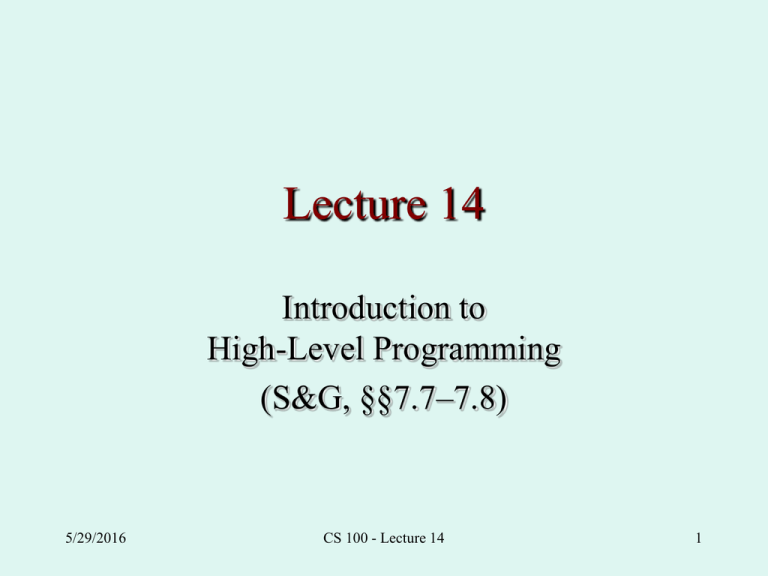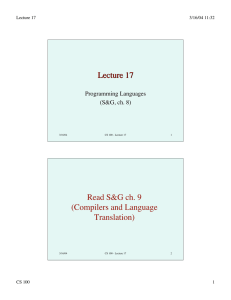Lecture 14 Introduction to High-Level Programming (S&G, §§7.7–7.8)
advertisement

Lecture 14 Introduction to High-Level Programming (S&G, §§7.7–7.8) 5/29/2016 CS 100 - Lecture 14 1 Read S&G: §7.10 (Software Engineering) and ch. 8 (The Tower of Babel) 5/29/2016 CS 100 - Lecture 14 2 The Phenomenology of Tools 5/29/2016 CS 100 - Lecture 14 3 Phenomenology • A philosophical method • A phenomenon is some aspect of concrete human experience of the world • Phenomenology investigates the invariant structure of some phenomenon by systematic variation of that experience • Has its own technical terminology 5/29/2016 CS 100 - Lecture 14 4 Phenomenology of Tools • The phenomena of concern are tools in the broadest sense • Developed by Don Ihde • Here we are concerned with tools related to computers: – – – – – 5/29/2016 computers themselves programming languages word processors email etc. CS 100 - Lecture 14 5 Tools are Ampliative & Reductive • Example: using stick to knock down fruit • Ampliative aspects – Greater power or performance – Extended experience • Reductive aspects – Experience is less immediate – Action is channeled by the tool 5/29/2016 CS 100 - Lecture 14 6 Examples • Consider ampliative & reductive aspects of: – – – – – – 5/29/2016 eye glasses automobiles telephones email recorded music internet CS 100 - Lecture 14 7 Utopians vs. Dystopians • Technological utopians: – focus on ampliative aspects – emphasize practical advantages • Technological dystopians: – focus on reductive aspects – discount practical advantages • Both attitudes are reduced focuses • Better: – acknowledge essential ambivalence of our experience of the tool – “all technology is non-neutral” — Ihde 5/29/2016 CS 100 - Lecture 14 8 Phenomenology of Programming Languages • Ampliative aspect: – automation of tedious, error-prone activities – error checking • Reductive aspect: – loss of direct control of machine resources – possible inefficiency 5/29/2016 CS 100 - Lecture 14 9 “Fascination” & “Fear” • Typical responses to a new technology • Utopians are fascinated by ampliative aspects – embrace & promote the new technology – tend to over-apply the new technology – inclined to further amplification • Dystopians fear reductive aspects – may view ampliative aspects as dangerous – ambivalent feelings of power or helplessness • Greater familiarity balanced understanding of benefits & limitations 5/29/2016 CS 100 - Lecture 14 10 Mastery & Embodiment • Tool replaces immediate (direct) with mediated (indirect) experience • When tool is mastered, its mediation becomes transparent (not invisible) • Contrast: – bad tool or unskillful use experienced as object, relate to it – good tool & mastery partially embodied, relate through it • With mastery, objectification becomes embodiment 5/29/2016 CS 100 - Lecture 14 11 Focus & Action • Example: three writing technologies – dip pen – electric typewriter – word processor • Tools influence focus: – makes some aspects of situation salient, hides others • Tools influence action: – makes some actions easy, others awkward • Tools subtly influence what we notice and do 5/29/2016 CS 100 - Lecture 14 12 Cultural Embedding • All technologies are culturally embedded • Our reactions to them are influenced by: – personal backgrounds – collective background • Stylistic inclinations may vary from user to user 5/29/2016 CS 100 - Lecture 14 13 The Life Cycle of Programs: Waterfall Model Analysis -----------Verify Design -----------Verify Implementation ------------------Test Integration ------------Test Maintenance 5/29/2016 CS 100 - Lecture 14 (slide < S. Levy) 14 Maintenance • Programs might have a lifetime of 5-20 years • Requirements might change, and minor or major changes would be necessary 5/29/2016 CS 100 - Lecture 14 (slide < S. Levy) 15 The Cost of Correcting an Error Cost of Correcting a Fault analysis implementation maintenance integration design Software Development Phase 5/29/2016 CS 100 - Lecture 14 (slide < S. Levy) 16 The Relative Costs of the Phases 5/29/2016 CS 100 - Lecture 14 (slide < S. Levy) 17
